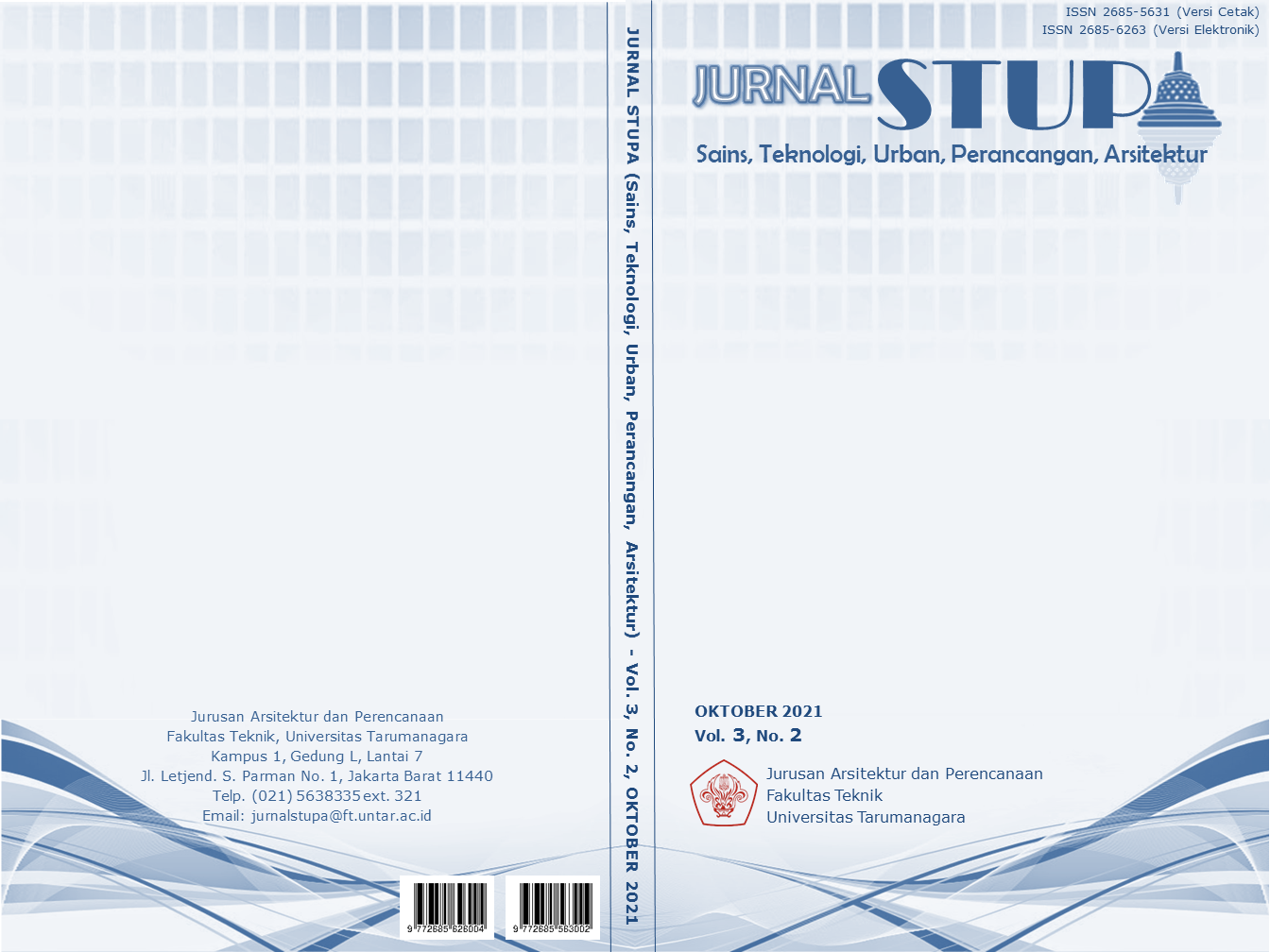KABONG KAENG: TIPOLOGI BARU HUNIAN EKOLOGIS SUKU ASMAT
Main Article Content
Abstract
Climate change is a global phenomenon that has recently become a common concern, which has an impact on increasing air temperatures. The Jayawijaya Mountains, which are known for their eternal snow, have changed and have an impact on the drastic increase in humidity in the area. This unique phenomenon in Papua, especially the Asmat tribe, which is rich in natural products, but on the one hand is experiencing a clean water crisis. Many diseases are caused by poor water conditions, because some people use river water without being treated first. The problem of water crisis is a major problem because the Asmat tribe is very dependent on nature, starting from their food needs, toilets, to their traditions and arts. If nature is getting more and more damaged, how will the Asmat tribe survive and adapt in the future? The architectural approach taken is the typology method, which analyzes the characteristics of the life of the Asmat Tribe, to then be applied to the project. In addition to overcoming existing problems, this project also raises the way of life of the Asmat Tribe which is closely related to sculpture and traditions in the realm of their ancestors. Through various research, it is possible to use humidity and rainwater as a source of water in the future. In terms of energy, it is said to be sustainable because of the high rainfall in Papua. The impact on the ecosystem is not negative because it comes from nature. This water source can be used by the Asmat tribe to adapt to their way of life and utilize this water source for the sustainability and preservation of their civilization in the future.
Keywords: Ecohydrology Architecture; Dwelling; Clean Water Crisis; Asmat Tribe; Typology
Abstrak
Perubahan iklim merupakan fenomena global yang belakangan ini menjadi perhatian bersama, dimana berdampak terhadap peningkatan suhu udara. Pegunungan Jayawijaya yang dikenal dengan salju abadinya menjadi berubah dan berdampak terhadap peningkatan kelembaban udara drastis di kawasan tersebut. Fenomena unik di Papua, khususnya Suku Asmat yang kaya dengan hasil alamnya namun disatu sisi mengalami krisis air bersih. Banyak penyakit yang diakibatkan oleh kondisi air yang buruk, karena sebagian masyarakat menggunakan air sungai tanpa diolah terlebih dahulu. Masalah krisis air menjadi permasalahan pokok karena Suku Asmat sangat bergantung dengan alam, mulai dari kebutuhan pangan, MCK, hingga tradisi dan keseniannya. Jika alam semakin rusak, bagaimana cara Suku Asmat bertahan hidup dan beradaptasi kedepannya? Pendekatan arsitektur yang dilakukan adalah metode tipologi, dimana menganalisis karakteristik kehidupan Suku Asmat, untuk kemudian diterapkan terhadap proyek. Selain mengatasi permasalahan yang ada, proyek ini juga mengangkat cara hidup Suku Asmat yang erat dengan kesenian pahat dan tradisi di alam nenek moyangnya. Melalui berbagai riset, bahwa memungkinkan untuk memanfaatkan kelembaban dan air hujan sebagai sumber air di masa depan. Dari sisi energi, dikatakan sustainable karena curah hujan tinggi di alam Papua. Dampaknya terhadap ekosistem tidak negatif karena berasal dari alam. Sumber air ini dapat dimanfaatkan Suku Asmat untuk beradaptasi cara hidup dan memanfaatkan sumber air tersebut untuk keberlanjutan dan pelestarian peradaban mereka di masa mendatang.
Article Details
References
Apriyono, A. Setyo, Sekar M. P. (2015). Kebudayaan Suku Asmat. Surakarta: ISI.
Buckhori, D. (2017). Definisi Ekologi. Diunduh 2 Maret 2021, dari Ipb.ac.id: http://damayanti.staff.ipb.ac.id/files/2012/09/Pendahuluan.pdf.
Ching, F D.K. (tj. Hillarius Hardani). (2000). Arsitektur Bentuk, Ruang dan Tatanan. Jakarta: Erlangga.
Ernst H. (2013). History of Ecological Science. Washington DC: ESA.
Haryanto, I. Januari 5, (2017). BMKG Khawatirkan Puncak Es di Gunung Jayawijaya Meleleh Tahun 2020. Diunduh 2 Maret 2021, dari https://news.detik.com/berita/d-3388887/bmkg- khawatirkan- puncak-es-di-gunung-jayawijaya-meleleh-tahun-2020.
Heidegger, M. (1971). Building Dwelling Thinking. New York: Harper Colophon Books.
Lang, J. (2005). Urban Design, A Typology of Procedures and Products. Oxford: Architectural Press.
Liyana, G. R. (2014). Potensi Air Melimpah Tak Menjamin Indonesia Bebas Krisis Air. Jakarta: Gerry’s Note.
Rapoport, A. (1982). The Meaning of Built Environment. Baverly Hills: Sage Publications.
World Resources Institute (WRI). (2019). Kekurangan Air yang Ekstrem. Washington DC: WRI.



